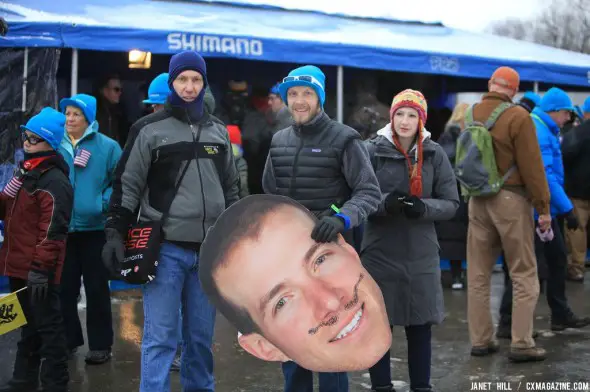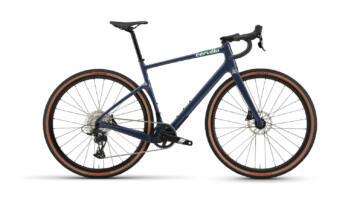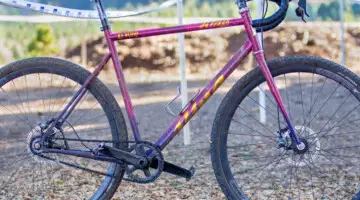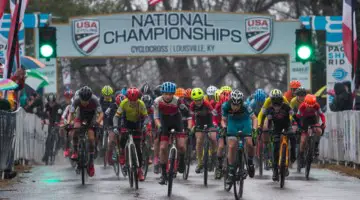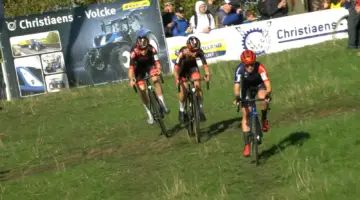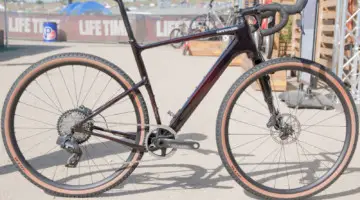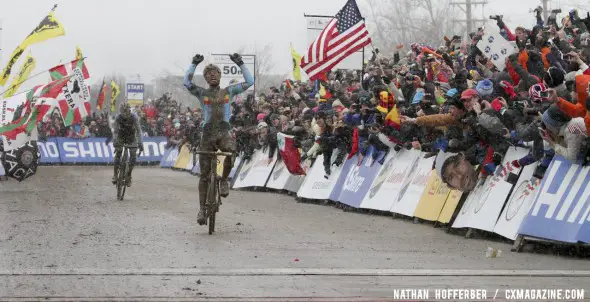
Sven Nys wins his second Elite World Championship over Klaas Vantornout in Louisville, KY. © Nathan Hofferber
by Robbie Carver, Molly Hurford and Andrew Yee
With three races – and three Dutch winners – in the books, with temperatures dropping and crowds swelling, the tension at Eva Bandman park was palpable. The beer line thinned as spectators elbowed their way to the best spots on the course. Costumed spectators took up their cowbells, their horns, their cymbals. A trumpet blared the unmistakable Call to Post of the Kentucky Derby, and a tsunami of cheers rose up from across the course. Richard Fries screamed, “Elite men report to staging!”
It began. The last race of the day, the first chance for many Americans to watch racers who they had only read about, only watched on pirate livefeeds over the years. We don’t need to remind our readers how the races went down: you were there, or you were watching, or you read about them. You shared in the excitement of the day.
After the race, we at Cyclocross Magazine sat down to discuss what we thought were the high and low points. From covering the first heats of the Masters Worlds, to interviewing the worlds’ best Elites before and after the championships, to conducting immersion journalism at the afterparty and wading into the flooded course on Sunday, Cyclocross Magazine was there, every step of the way, bringing you the best coverage we could, collecting our thoughts of the event as we went. Sure, there were some problems with the overall organization of the week. But there were plenty of successes too – especially where it mattered most.
The high point of the race was obvious: the stunning enthusiasm of the spectators, all loud, excited, and ready to cheer for everyone, not just their favorite American racers. They threw heckles and cheers, not beer, calling Euros out by name, cheering for last place as vigorously as first. The crowds brought their A game, and showed the Old World what US cyclocross is all about – community.
Almost 10,000 people were at the event, a full 2,000 more than the best-case projections that USA Cycling had made. Add all the online views of the race, plus the UCI live coverage that was watched worldwide, and we know it was by far the best-watched cyclocross race ever held in the US.
The course itself proved to be World Class. Sure, a dry, sunny day may have brought a few more to the front of the field, but on frozen, muddy, snowy Saturday, the strongest riders prevailed on a challenging, spectator-friendly course. We need no more validation than that the strongest riders – those that have been on top of the sport in Europe – won, which only helps our chances of bringing more top-level racing to the states. Can you say World Cup?
Racers, teams and countries can look at this World Championships and realize that the travel isn’t an insurmountable barrier to victory overseas – and the increased respect by Euro racers for the difficulties Americans tolerate to race in Europe was more than welcome.
Our last point of great success was the overall teamwork that went into building this event. Organizations like the UCI and USA Cycling and promoters and media aren’t always known for getting along, so when push came to shove, it was great to see everyone work together to make the event a success. This event, dreamed up by Bruce Fina and Joan Hanscom, was in jeopardy many times since the announcement of their successful bid. Debating all the reasons as to why could go on endlessly, but the important thing to remember is that the original team deserves credit for laying the groundwork for the dream, and even though USA Cycling did not have to step in to save it, they did. If having the world championships on US soil added a little excitement to your life, from higher-stakes racing earlier this season, watching our freely-available live video coverage, or actually attending the event in person, then we need to thank USA Cycling for helping make that experience happen.
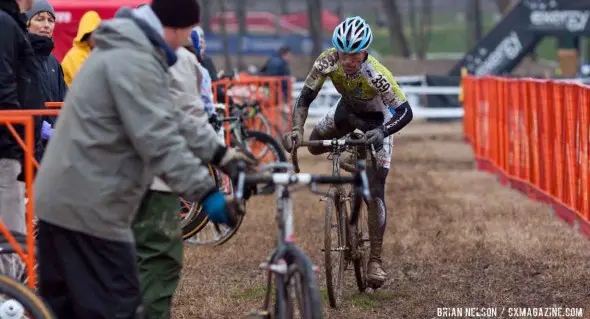
Masters Worlds pit crew members are required to have or buy a license to work the pits. © Brian Nelson
Of course, it wasn’t all the perfect race or week. One of our top issues was that the fan experience really needed to be bumped up a bit: we were hearing about huge waits for beer and food (not that we had a chance to eat or drink!) and lines for the Port-a-Potties. When paying that much (or anything, since we’re used to free spectating!) for a race, centering it around the fan experience is key. A spectator shouldn’t have to stand in line for half a race to get food and drink: European races have more options, and more locations to keep that fan happy. Recruiting a dozen food trucks would have gone a long way to keeping people fed, hydrated and, if desired, inebriated. A fan shouldn’t have to navigate a slick, muddy hill and a maze of limited course crossings to find the expo – in fact, a lot of people we talked to never made it down to the expo area simply because there was no signage pointing it out.
Speaking of the expo, paying companies help make such an event happen, and while the flood-related rescheduling really constrained a spectator’s (and journalist’s) free time to make it to the expo, moving the expo to an area near the entrance would have given vendors a much better chance to attract eyeballs to their products and brands. We want companies to invest in our sport and a ensuring high return-on-investment experience for vendors is essential.
Let’s not forget about the Masters. These guys work day jobs, spend good money to attend the event, and we should treat them like the world-class athletes they are, and treat the event as a true world championships. Unclear rules on which races have qualifying heats and who is allowed to work the pits added to early-race drama and impacted travel plans, while insufficient and frozen power washers played a major role in the races and results. If we’re going to call such races World Championships, let’s provide world-class support and communication.
It goes without saying that proper communication, homework and planning is essential for a smoother lead-in to the race. Switching ownership certainly didn’t help, but providing more transparency and being receptive to input along the way would allow more of the community to pitch in and help make it a success. When shown with data and evidence of flood danger (as we did in April 2011), a more open discussion from the organizers could have perhaps avoided the rescheduling risk.
It’s unfortunate that within some of the stages of planning, denials of any difficulty and a lack of communication made learning about the event, and certainly, reporting on it, difficult. But more importantly, those actions didn’t foster a sense of ownership from the community, and we think this was a major factor in the drama, turmoil and takeover in the months leading up to the event. We’re extremely proud of our country hosting its first-ever World Championships. We are proud to not only have donated a significant amount of advertising space to USA Cycling, but to have been the news source that you came to for all the happenings during that eventful week. And we are grateful for all the volunteers, racers, spectators and most importantly, the organizers who made it happen. It’s an achievement worth both celebrating and learning from, so that we can once again enjoy the thrill of the very best racing in America.
Here, the three of us that were “on the ground” for the week just wanted to take a minute to share a few of our thoughts, and more importantly, say thank you to our readers for your amazing support and kindness this week. We will be continuing our Worlds coverage both online, and in our upcoming Issue 20, so if you’ve loved our coverage and want such comprehensive coverage to continue next year, please take a moment to subscribe to our print magazine – we do this for you, and cannot do it without you.
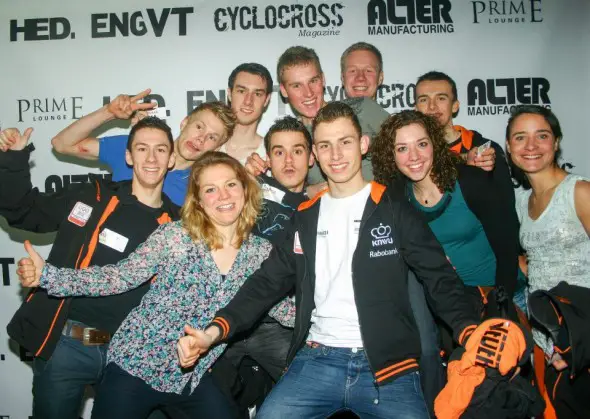
An entirely social media driven party brough in Lars van der Haar, Sanne van Paassen, Mike Teunissen, Sabrina Stultiens and Marianne Vos: three of the four World Champions (Sven Nys showed up later as well!) © William Huston
From Chief Cowbell Ringer Andrew Yee:
Last minute rescheduling, logistical hiccups and a near sweep of the podiums by the Europeans was not what American fans were dreaming about when Worlds was awarded to Louisville, Kentucky. Yet as I sprinted back to the media center after the podiums, I couldn’t help but notice the palpable excitement and see the huge smiles on almost every spectator’s face as everyone left the venue.
Sure, many of us hoped for a few more medals or even a rainbow jersey for the US team, but what could be more fitting for a World Championship than having the two most dominant cyclocrossers in the World win Elite Men’s and Women’s titles? Especially in the men’s race, if we couldn’t have an American on the top stem, Nys would have been the overwhelming American fan favorite, and the chants from the crowd clearly revealed the delight he delivered with a close-fought win over Klaas Vantornout.
Tim Johnson told Cyclocross Magazine he wished he could do another lap to soak in the once-in-a-lifetime energy and raucous support of the crowd, and wanted the finishing straight to go on for miles. I can certainly relate, as seeing and feeling the energy of our cyclocross community, on display at the sport’s highest level, was a thrill that I didn’t want to end and made this crazy venture I’ve been toiling at for five years more than worthwhile.
Any time my head wasn’t stuck behind a camera or my laptop screen, I couldn’t move 10 feet without being stopped by an appreciative reader of our website or magazine, and the recognition that the magazine gets was uplifting and energizing for me and my on-the-ground team of Molly Hurford, Robert Carver, John Proppe and Taylor Kruse. As we braved the mud, snow, ice and winds at Masters Worlds, and chased down racers on Saturday for interviews, we did so knowing that you, our reader valued our work.
Just like Worlds, our coverage didn’t go perfectly, but in the end, it was an overwhelming success, thanks to all of you who viewed and shared our work. Enjoy your off-season, but stay tuned to our magazine and website, because as for us, we’re just getting warmed up.
From Editor Robbie Carver:
I returned from Louisville, pumped and exhausted, to a stack of student papers waiting to be graded, a desk of bills needing to be addressed, and a stable of bikes in dire need of maintenance. What did I do? I poured myself a cup of coffee and re-watched the World Championship races. All of them.
I was again at the start line, feeling my heart drop when Logan Owen jumped at the final red, realized his mistake, and then had the field swarm around him. I was again on the sidelines, pausing in my frantic tweeting to scream myself horse as Zach McDonald rode by. I was again at the finish line, waiting with microphone in hand as a devastated Katarina Nash composed herself enough to lament dropping her chain on the finishing stretch, her second Worlds podium vanishing as Lucie Chainel-Lefevre shot around her. And I again lost all pretense of professionalism as Sven Nys, always the tactician, capitalized on Klaas Vantornout’s split-second mistake to take what may prove to be the most important win of his—and US cyclocross’—career. To be frank, I lost my … well, you know.
Because here’s the thing: It almost didn’t happen. Any of it. Not the utter dominance of the Dutch riders in the first three races, not the drama of Pauwel’s and Page’s chains jamming, not the always impressive throw down of power as Compton worked her way through the field. The financial woes, the disorganization as USAC attempted a last-minute step in, the drama of swiftly rising flood water—any one of these could have spelled event-ending disaster, and we may never have seen an international cyclocross race held on American soil again. Amateurs. Rookies. Backyard bunny-hoppers. Not true veldrijden. Not worthy. But we stepped up. The money came through, the banners went up, the parks and rec crew worked tirelessly to keep the water at bay and a full day of racing commenced on a track that clearly justified itself as world class.
Most importantly, however, the fans came through—and that’s what I, US ’cross, and every single European will be taking home with them. We made this a world class event, yes, but we made it our own—ten thousand fans out-decibeled Koksijde’s 60,000. Cowbells, heckles, horns, from Sven Nys to New Zealand’s Alexander Revell: racers couldn’t believe the wall of noise that fueled them through the course, regardless of their place. “We raced for you,” they said. “There’s no way I could have done that without the crowds cheering me on.”
Was it perfect? Far from it. Do we have a lot to learn? Absolutely. Most importantly, however: Did we give the world something uniquely American and validate ourselves in the eyes of international cyclocross? We did.
Finally, a personal thanks to everyone who came up to Molly, Andrew and myself and thanked us for our coverage. It means everything to us to know we are providing the ’cross community with quality reporting and media. Like the event itself, we still have a lot to learn, but we can’t wait to go another round.
From Managing Editor Molly Hurford:
For me, going to Worlds was like coming home. In the course of the week, I barely slept, worked 18 hours a day, went through virtually every emotion a person can go through, lost my phone, lost my voice, lost my ability to regulate body temperature … but never once wanted to stop smiling.
Like I said. It was like coming home. The cyclocross community is (sometimes literally, in the case of my parents driving from New Jersey all the way down to watch the race and watch me work, but more often figuratively, in the case of the entire New England scene) my family. So when 10,000 people swarmed on Louisville for the event … Every place I went, it felt like home. People would come up to Robbie and I and thank us for our coverage, and tell us that they love the magazine. And that makes the numb fingers infinitely worthwhile.
When we showed up at the legendary Foam Party, what I remember most vividly about that night was a few people in the crowd starting up a “USA, USA” chant, only to be almost immediately eclipsed by a crowd-wide chant of “SVEN, SVEN, SVEN,” because even the World Champion came out to party.
Most of all, this week reminded me why we do what we do. The number of people who came up to me, to Robbie, to Andrew, to tell us that our coverage was awesome, that they were happy we were covering the Masters races, that they were impressed with how much content we were putting up … the fact that you noticed and appreciated that meant more to us than anything. When you spend so much time in a vacuum of watch-cover-write-publish, sometimes you find yourself asking, “Is anyone even seeing this?” Often, that’s asked at 4 AM when you’re still up working and are delirious. Delirious or not, it means so much to all of us that not only are you reading and watching our coverage, but you understand how much it takes to get all of that out to you, and we are so grateful for the chance to do just that.
Was Worlds perfect? I know we’ve pointed out the flaws, and we’ve admitted we have a lot to learn. But with the crowds cheering so loud I’m sure they could be heard across the river, with the dull roar that went up when Sven Nys took the win, with all of these racers, these rockstars, these legends, coming to the US and saying, “we loved this,” you know what?
It was perfect.













